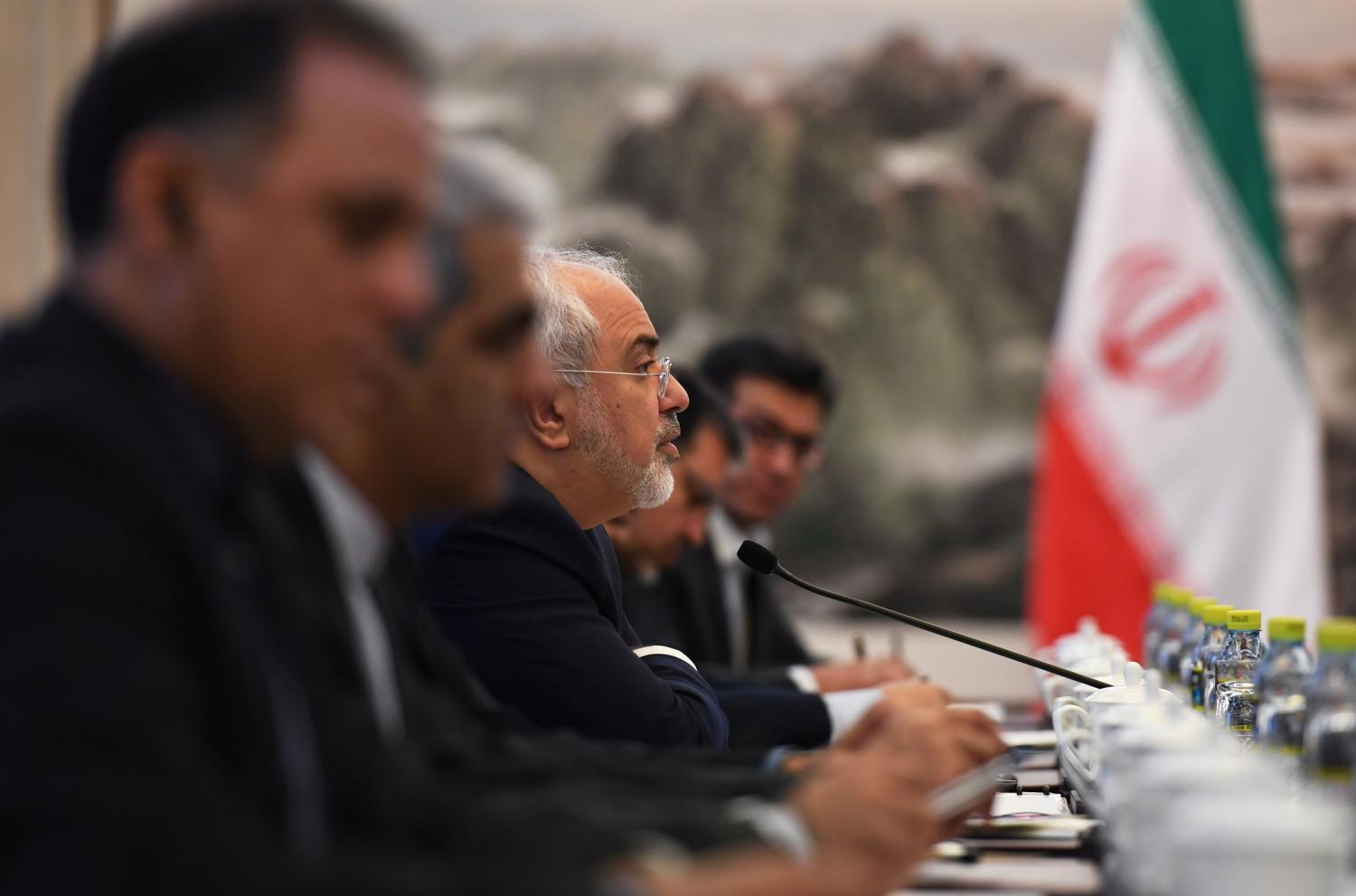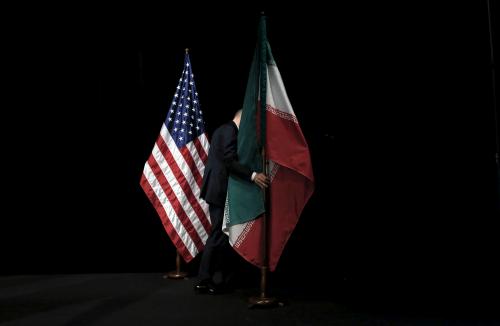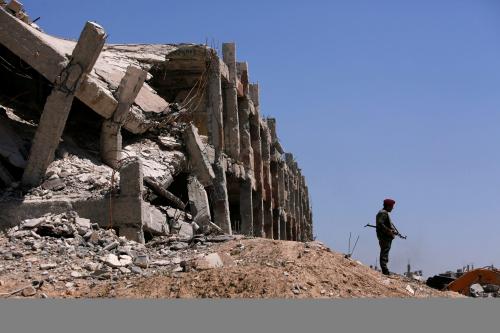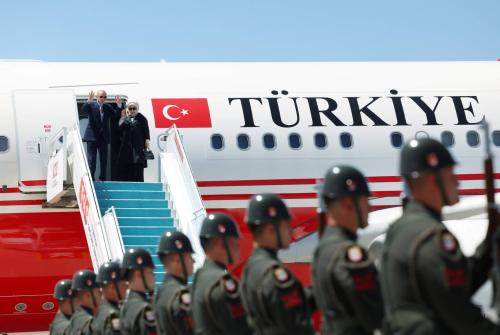In the hours after last week’s joint U.S.-U.K.-French airstrikes on Syria, President Trump tweeted that the operation was a “mission accomplished.” That declaration reinforced other signals from the administration that the retaliation against Bashar al-Assad’s latest chemical attacks on civilians would firmly avoid any open-ended military engagement in the Middle East, a region that Trump described in his statement as “a troubled place” whose “fate…lies in the hands of its own people.”
By coupling his show of force with an insistence on extracting Washington from the Middle East, Trump was speaking to his domestic constituency, whose weariness over the human and economic cost of the Iraq and Afghanistan conflicts contributed to the appeal of his unconventional candidacy in the first place. But his message was heard—and welcomed—well beyond his base.
In Tehran, Trump’s exceedingly narrow definition of American interests in Syria offered an unexpected, and timely, reversal of fortune. With pressure mounting on the Islamic Republic from within and without, the strike and the speech provided tangible reassurance that despite the administration’s pugnacious rhetoric, Washington has no intention of taking on Tehran directly to roll back its regional advances. And the mission’s evident risk aversion and embrace of cooperation with Europe boosts the prospects that some similar formula might persuade Trump to retreat from his threats to jettison the 2015 nuclear agreement and the sanctions relief that Iranian leaders need so badly. At least for the moment, in yet another appalling paradox of Syria’s ruinous war, Iran is emerging as the big winner from the latest skirmish.
Trump versus his team
That surely was not Trump’s intention. During his quixotic run for the White House, Iran represented a rare point of consensus between the real estate mogul and the Republican political establishment. And since taking office 15 months ago, President Trump has succeeded in reanimating the longstanding U.S.-Iranian estrangement, taking particular aim at the Joint Comprehensive Plan of Action (JCPOA) and routinely excoriating Iran’s government and its policies. In both rhetoric and actions, the administration has ranked Iran at the top of America’s regional agenda, and his determination to shift U.S. policy toward Tehran from accommodation to confrontation reinforced enhanced cooperation with traditional allies such as Israel and Saudi Arabia.
And yet there was always a disconnect on Iran between the president and his senior appointees and advisors. From the start, Trump’s interest in Iran was fixated on the JCPOA, because as he has argued, “(i)t gave Iran far too much in exchange for far too little.” However, he has been equally consistent about his disdain for an expanded U.S. military footprint in the Middle East and the associated costs. In February, Trump decried: “$7 trillion in the Middle East. And the Middle East is far worse now than it was 17 years ago when they went in—and not so intelligently, I have to say—went in. I’m being nice. So it’s a very sad thing.”
This transactional interpretation of American interests in the region separates the president from his rotating cast of national security officials. Across the board, they share Trump’s hawkish stance on Iran, but have articulated a more nuanced view on the efficacy of American power. Still, the buck stops with the president, even one who is more familiar with Twitter wars than actual combat. It should come as no surprise that, when presented with the prospect of escalation in response to a more comprehensive strike, Trump opted to steer clear of any slippery slopes.
A tough posture, weakened?
The episode raises intriguing questions for the broader dynamic between the Trump administration and Tehran. With only weeks remaining before the president’s self-imposed deadline for “fixing or nixing” the nuclear deal, intense negotiations are underway with the United Kingdom, France, and Germany around an effort to craft a common position on toughening the terms of the 2015 agreement. This is a fraught endeavor, since the Europeans seek to avoid undermining the original deal while the White House has pressed for measures that would surely provoke a crisis with Tehran and possibly upend the agreement.
The Europeans’ not-so-subtle strategy for avoiding a breach has been to focus on expanding the pie, in the hopes that enhanced trans-Atlantic cooperation around deterring Iran’s regional sway can buy greater U.S. latitude on the effort to bolster the JCPOA’s constraints. In that sense, British and French participation in the Syria strike offered visible collateral that they hope to leverage into a broad compromise with the White House. French President Emmanuel Macron has suggested that the cooperation on the strike is already paying off with a shift in Trump’s stance on Syria.
The survival of the nuclear agreement remains a long shot. Trump remains convinced the JCPOA is a “terrible, one-sided…horrible deal,” and his latest national security advisor has charted a strategy for unravelling it and repeatedly expressed a preference for a military solution to Iran’s nuclear ambitions. But Syria illuminates just where the president’s risk threshold lies: At the chance of a conflagration that could drag American troops into another extended regional war, Trump will blink. The Europeans should capitalize on this and find a way to preserve the only tool that has proven effective in constraining the Islamic Republic: a tightly-knit common front between the United States and Europe.
The view from Tehran
The Iranians intuitively recognize the American aversion to another spiraling military engagement in the Middle East, and their own regional strategy is designed to exploit this vulnerability. In a video published in November 2017, Qasem Soleimani, the Quds Force commander who has orchestrated Tehran’s expanding sway over Iraq and Syria, boasted that Iranian forces “have no fear of death, we move forward with our operations with logic and accuracy, and we analyze the enemy.” He contrasted this resolve with what he ridiculed as American weakness, charging:
“there are more than one million American forces, but no faith. So, when they come to Iraq, they use diapers so their troops will not have to leave the tank when they are scared. This is while you [Iranian-backed militias], with your Kalashnikov and simple guns, have achieved glories. This is because you were ready to devote your life.”
For Iran’s leadership, Syria is a cause worthy of devoting considerable blood and treasure—not simply because of the religious attachment to Shiite shrines in Damascus, or its symbolic value as the revolutionary state’s sole Arab ally during its darkest hours of war with Iraq, or even its strategic value as a logistical conduit to Tehran’s indispensable proxy and partner, the Lebanese militia Hezbollah. All these factors helped persuade Iran to gradually expand its commitment to securing Assad’s survival; however, it was the emergence of the so-called Islamic State that transformed the stakes and the nature of Iran’s intervention.
But for the Islamic Republic, necessity has always been the mother of invention and the formula for the regime’s survival; from threat emerges opportunity and innovation.
But for the Islamic Republic, necessity has always been the mother of invention and the formula for the regime’s survival; from threat emerges opportunity and innovation. Conveniently, Syria delivered, via the Islamic State, whose vicious sectarianism helped to precipitate Iran’s unprecedented mobilization of a transnational Shiite force. Supplementing Iran’s existing proxies with brigades of desperate or mercenary South Asian Shiites, Soleimani has preserved Tehran’s investment in Assad and steadily positioned Iran as the predominant military and political power across the Arab heartland. And his expeditionary Shiite forces insulated the regime from the human toll of the Syrian conflict, even as Tehran sought to use the specter of a looming jihadi threat to the homeland to rally Iranians’ kneejerk nationalism. “Just imagine if we were not there?” Deputy Foreign Minister Abbas Aragchi mused recently in a BBC interview, invoking the specter of an unchecked Islamic State. This has some resonance with Iranians, even today. For the rest of the world, imagining how Syria might have evolved absent the slaughter that Tehran helped unleash is a cause for epic remorse.
Toward a real game plan
Tehran will not readily relinquish its hard-won prize; to cede Syria via diplomatic theatrics is not just unnecessary, it would be a perilous admission of weakness and an invitation to dismantle the architecture of Iranian influence just as it has achieved its pinnacle. Iran’s leaders expect to see a return on their extraordinary investment in Syria, in the form of strategic depth and reconstruction contracts. Even as Trump was tweeting furious warnings of imminent American reprisals last week, Ali Velayati, Iran’s former foreign minister and the personal representative of the supreme leader, was dispatched to Damascus, where he praised Assad and visited eastern Ghouta, where Iran has helped the Syrian regime to reclaim control in gruesome fashion. The message was clear: Iran is in Syria for the long haul; come after us if you dare.
Trump did not take that dare. Neither did his predecessor. This reflects a durable, though episodically anguished, consensus within the American political and strategic establishment: We are not ready to devote our citizens’ lives to saving Syria. Neither, for that matter, are most of Syria’s Sunni Arab neighbors, as the Trump administration will quickly find in shopping a plan to mount a regional stabilization force.
Israel, however, is another matter. Now that Assad has prevailed, Israel is facing a permanent presence of hostile Iranian forces along its borders, digging in and forging the infrastructure to supersize its capability to menace a state whose demise its leadership routinely implores. The slow-burning shadow war between Israel and Iran will almost surely intensify in the weeks to come, even as the May 12 deadline for preserving the nuclear deal looms.
The Islamic Republic is anything but a suicidal regime; Soleimani will probe to maximize his room for maneuver, but Tehran will be keen to avoid overreach, especially at a time of profound domestic uncertainty. There is a pathway to containing and deterring Iran in Syria and Iraq, but it requires more than just Israel’s itchy trigger finger and cheerleading from the sidelines by Arab autocracies. It requires a White House that can rise above chaos and dysfunction to transform Trump’s unusual blend of provocation and prudence into a viable strategy. It requires deep coordination with American allies and the deployment of both military and diplomatic resources beyond the occasional self-satisfying missile barrage. Most of all, any game plan that can succeed in countering Iran’s regional threat requires President Trump to snatch victory from the jaws of defeat and strike a compromise with Britain, France, and Germany to preserve the JCPOA and avoid a needless nuclear crisis.
The Brookings Institution is committed to quality, independence, and impact.
We are supported by a diverse array of funders. In line with our values and policies, each Brookings publication represents the sole views of its author(s).








Commentary
Trump, promising hellfire in Syria, blinked. Why that could bode well for the Iran deal
April 18, 2018